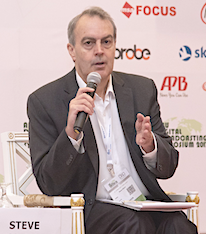Steve Ahern says better professional media is needed to combat fake news.
Remember the busses that were supposed to have brought anti-Trump protesters to Austin Texas? It turned out to be a fake news report, but was spread far and wide before the ill-informed social media blogger, who posted it without checking, took it down. It was widely referenced by party-political social media accounts and lazy journalists.
And who can forget Donald Trump’s endorsement by the Pope… not.
As countries from Malaysia to Germany head for elections this year, governments are looking for ways to fight fake news and ensure accurate and informed debate.
The Malaysian government last week launched an official website to debunk fake news stories, and in Europe, some governments are considering legislation to punish those who publish fake news.
But opponents of fake news sometimes forget an anti-fake-news resource that has been around for a long time – professional media.
Staff in professional newsrooms check facts, confirm sources and deliver accurate news every day, but they need help and support to do it better in this era of fake news. This is the time to resource them well enough to provide inoculation against the insidious virus of fake news.
Responsible broadcasters and publishers already have established reputations for publishing credible news, but they risk losing that reputation if they do not adapt to the changing environment that has spawned fake news.
Propaganda, fake news and opinion masquerading as fact have been around forever, but the difference now is that the internet and social media spread the contagion faster and further than ever before.
It’s about reach and scale. Broadcasters need big audiences and large social media networks to spread their real news just as fast as the fake news. While commercial broadcasters realise this reality, some public service broadcasters have not got the message yet. They are too slow to respond, and their social media connections are not deep enough to facilitate virality. The best of them, like Australia’s ABC and the BBC, are experimenting with new ways to push out their news, such as the ABC’s news bot on Instant Messenger and the BBC’s commitment to monitoring trending words and hashtags.
Some public service broadcasters have been slow to reinvent themselves in this new media age, and are falling behind in speed and relevance. They need to catch up.
Other government broadcasters have lost the trust of their audiences by publishing only government propaganda. They are slowed down by bureaucratic approval processes and publish only one sided reports, so, when it really matters to counter fake news, citizens do not believe them.
If governments spend all their time stifling debate and pushing out only one view, they have no one to blame but themselves when the tide of fake news turns against them. Building an informed open society that values accuracy, debate, mutual respect and understanding is far better than trying to block good quality reporting and wide, respectful discussion.
In this era of so much competition in the news and information sphere, broadcasters and newspaper companies will live and die by their responsiveness and reputation.
When the world’s knowledge is always within reach on your smartphone, the mantra has to be smaller, faster, cheaper, social.
If professional news outlets are not delivering their content to the multi-media devices we now carry in our pockets quickly enough, their users will look elsewhere. But if trusted credible media brands turn up in our social media feeds just as quickly as the fake news, then there is some hope that people will discover what is true and disregard what is fake. They might even begin to flag fake news and push it off their social media feeds… let’s hope so.
An important strategy for credible media is to educate people to flag fake news and share real news. It is a positive move that social media sites are now introducing refinements to allow fake news to be flagged for checking, but they will be of no use unless the billions of people who use social media take control and help identify what is good journalism and what is fake news.
If professional news outlets do not gather the largest possible following on social media, no matter what they publish, it will not be distributed widely enough to matter. Rapid wide distribution is possible now for a fraction of what it used to cost.
The most effective media now is smaller, faster, cheaper and more social than it was before. Professional media must evolve to meet the needs of the changing new environment.
Even the definition of fake news is changing. At first it meant what the term suggests, news reports that were fabricated, without verification, and false. Now fake news to some people means ‘news I do not like’ or ‘something I don’t agree with,’ which has muddied the waters when it comes to discussing this issue. For clarity, in the world of ‘alternative facts,’ what I am talking about is false news. The rest is spin.
I don’t begrudge PR people the opportunity to spin a story. It’s their job. But it is the job of professional journalists to question that spin, check facts, seek opposing opinions and present a balanced report which quotes verifiable sources and presents a well rounded picture of the issue.
A healthy, balanced media environment is also essential for good journalism to thrive.
In Australia, we are lucky enough to have three strong media sectors: commercial, public service and community media. They fiercely compete, but that competition strengthens the whole media ecosystem and generates energy that attracts bigger audiences.
Good journalism costs money, but it is becoming more clear in these times of fake news, that the money is an investment, not an expense.
Commercial media businesses respond to budget pressures and look at their output from a viewpoint of cost effectiveness. But are they looking hard enough? Businesses that have stood the test of time know that short-term budget thinking may help the immediate bottom line, but it may not always guarantee survival in the long term. If the consequence of cost cutting is slow responsiveness and inaccurate content then the long term survival of a serious media business will be put at risk. Strategic decisions about Cap Ex and Op Ex should have several objectives: making the business smaller, faster, cheaper and more social… not just cheaper.
Strong media brands have spent years building their reputations so that marketers could use the power of the brand to sell things and make a profit for the company. Don’t let the company’s brand value be eaten away by short term cost cutting that has long term damaging business effects. This doesn’t mean that everyone should have a job for life. Lazy, slow, time-serving staff in a newsroom are dead weights holding back the changes that need to happen to allow professional commercial broadcasters to respond appropriately to the changing media business environment. In Australia, and many other countries, media businesses have already felt the pain and hopefully made the right strategic decisions to position themselves for the future, but in other countries where I work I still see signs of times-servers holding back progress in newsrooms.
Community media has an important place too in this ecosystem. Those who are drawn to collective community media making have the chance to learn professional journalistic skills that will make their content better and ensure that it does not fall into the fake news trap. Community media strengthens society because it gives voice to those who may not be heard in mainstream media and allows for a wider understanding of all sides of an issue, supplementing government and commercial media with other viewpoints that may not otherwise be heard.
Governments should adequately fund true public service broadcasting so it can be responsive enough to counteract fake news.
Citizens who value credible information should recognise quality journalism by paying for it.
Advertisers who value a free market environment that helps their products become successful should put their money into credible media, otherwise the power of fake news may one day be used against them.
Good journalism matters, but it doesn’t stop there. Publishers and broadcasters have to compliment that good journalism with new-era business strategies that improve distribution, increase speed and build bigger audiences on as many new platforms as possible, so that the good work of their professional journalists is widely consumed. When that combination is achieved professional media will play a big part in providing the antidote to the fake news virus.
 This is an excerpt from a masterclass delivered by Steve Ahern last week at a media summit in Malaysia.
This is an excerpt from a masterclass delivered by Steve Ahern last week at a media summit in Malaysia.
Steve Ahern is a former commercial, community and public service broadcaster, programmer, senior executive and trainer who now runs his own company Ahern Media & Training Pty Ltd. AMT provides training, strategy and business mentoring for international media companies. He is the founding editor of this website.

